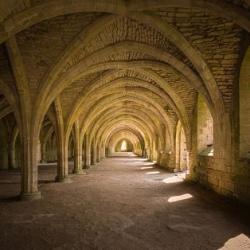To defend the resurrection, Paul indulges in a piece of cosmology (1 Corinthians 15:35-49), which circulates around seed, body, flesh, and glory. A seed goes into the ground and a plant comes up. Each seed has a body of its own, a gift from God, and each plant too has a body. The body of the seed becomes another body in the process of producing the plant, but “process” isn’t quite apocalyptic enough to catch Paul’s point: The seed has to die to produce the plant, and that death is a transfiguration from one bodily form to another (vv. 37-38).
This natural death-and-resurrection images the death-and-resurrection of the human body. Sown as one bodily form – perishable, shameful, weak, soulish – it dies and is transfigured into another body – imperishable, glorious, strong, and spiritual (vv. 42-44).
Embedded in this discussion of bodies in terms of seeds and plants, Paul offers a brief classification of creation’s creatures. The overall division is between creatures of “flesh” and creatures of “glory” (vv. 39-41). Creatures of flesh are men, beasts, birds and fish, creatures of earth. Sun, moon, stars do not consist of “flesh” but of glory.
In each class – the earthly class and the the heavenly – there is rich diversity: “all flesh is not the same flesh” (v. 39). Working backward through the creation week, Paul identifies four types of flesh: Flesh of men (Day 6), flesh of beasts (Day 6), flesh of birds (Day 5), flesh of fish (Day 5). Earthly, fleshly bodies have their own glory, but it differs from the glory of the heavenly body. We might socialize this portrait a bit more by bringing in the list from Revelation 19:17, where kings, commanders, mighty men, knights, and the rest of humanity seem to have different sorts of “flesh.” The flesh of kings is not the same as the flesh of their commanders, or the flesh of slaves. In Revelation 19, that could be taken quite literally: As far as scavenging birds are concerned, the sinewy flesh of an overworked slave isn’t nearly as deletable as the well-fed flesh of kings.
Then Paul moves to Day 4 to describe the glory of heavenly bodies, and again emphasizes the difference in glory among the sun, moon and stars. The glory of the sun is not the glory of the moon nor the glory of the stars, and even the stars differ from one another in glory.
Every created thing in Paul’s view has some sort of bodiliness. Some have fleshly bodies, but these fleshly bodies don’t have identical flesh; it may be accurate to say that Paul describes a hierarchy of flesh. Similarly, heavenly bodies are diverse in glory, and perhaps Paul means that there is a hierarchy of glory: The sun is most glorious because most bright, the moon less because less, and the stars least of all.
The overall point of the passage has to do with resurrection, which, within the cosmology Paul sketches, is a transfiguration from seed-body to plant-body, from flesh-body to glory-body. Or, as Paul explicitly puts it later in the passage, the first Adam is of the earth, earth; the Last Adam is of heaven, and those who are raised with and like Him will also become heavenly bodies, shining like stars in the firmament.














